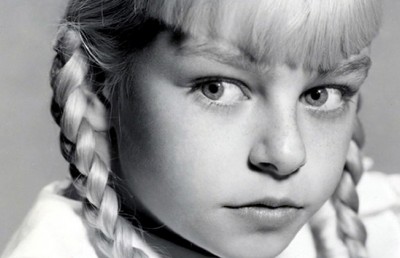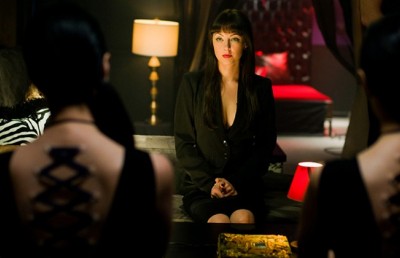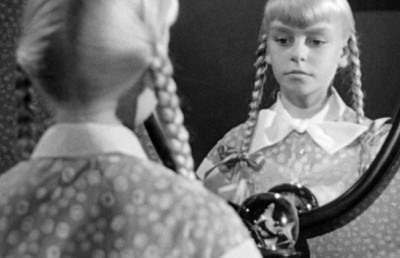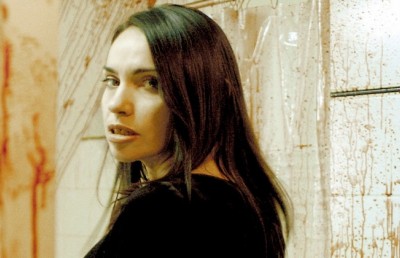Horror Grrrls
Feminist Horror Filmmakers and Agency
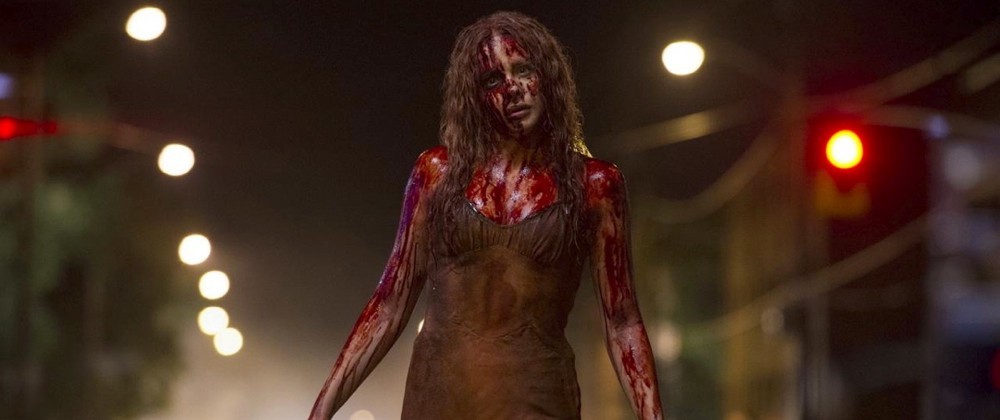
Introduction
The release of Jennifer’s Body (Karyn Kusama, 2009) attracted a lot of media attention on the topic of gender and horror. The marketing of the film revolved around the novelty that it was a Hollywood horror movie that was written and directed by women and was also being labeled as a “feminist horror film”. This quickly became a hot topic and generated countless articles in a variety of popular publications — such as The New York Times, Bitch Magazine, Fangoria Magazine, and Salon.com — which questioned the idea of feminism in horror. The majority of emphasis was put on the textual reading of the film and whether it could be considered feminist or not; most journalists overlooked the opportunity to research and write about other women working in the horror film industry, even though women have been directing popular horror films for a few decades (Pet Sematary (Mary Lambert, 1989), Near Dark (Katherine Bigelow, 1987), American Psycho (Mary Harron, 2000).
Inspired by a renewed interest in the question of gender and horror, Hannah Forman — an activist blogger and zine editor working under the pseudonym “Hannah Neurotica” who has been self-publishing the feminist zine Ax Wound: Gender and the Horror Genre for a few years — published a manifesto advocating the creation of the first annual Women in Horror Recognition Month (WIHM) in February 2010. The goal of the celebration was to urge people around the world to seek out the work of women writers, filmmakers, photographers or journalists working within the horror genre, and invite them to create sister events that would showcase the work of these women. The idea went viral on Facebook, blogs and horror news websites, attracting partners all over the USA and Europe; as a result, an entire community of female horror media makers was discovered through the different WIHM events. Furthermore, it brought the Viscera Film Festival to the forefront, which has been showcasing feminist horror shorts directed by women since 2007, as well as Pretty-Scary.net (since renamed Planet Etheria), a news website dedicated to genre films directed by women. It turned out the idea that women were interested in directing horror wasn’t such a novelty; the digital revolution had facilitated things for women, democratizing the means of production and giving them access to online networking and promotional platforms. What started as a simple strategy for providing more visibility for the work of women horror filmmakers turned into an online movement that has inspired women interested in or already working in horror to unite for a common cause: gender equality in the film industry.
In order to better understand the feminist dynamics at play in the women in horror movement and how the films made by these women can be interpreted as cultural texts which subvert the genre’s norms to transmit a feminist message, one must first look at the underlying social coding inherent in the horror genre.
Interpretive Communities of Female Horror Fans
In the late 80’s, Dolf Zillmann and Norbert Mundorf conducted a set of studies testing the influence of an opposite-gender companion on a viewer’s affective response to horror (Zillmann et al. 586), as well as how the effects of psychological patterns of gender identity — as opposed to biological gender — influence the viewer’s affective reactions to horror films (Mundorf et al. 655). In both cases, the sample of participants, comprised of university students enrolled in a communication study class, were exposed to a series of horror film excerpts and each individual participant’s reaction was measured and noted. In the first study, the authors advance that “the need or desire for exposure [to horror entertainment] is considered to be of social origin”, thus making horror films “socially instituted rites” that promote the mastery of fright and the control of panic through exposure to visual representation of threats (Zillmann et al. 586). In other words, horror films provide young people with the opportunity to test their courage and document it to their peers, especially when they watch said films in a group.
From results obtained from the first test, which paired a male and female participants before exposing the couples to chosen horror excerpts, the authors concluded that: when watching a horror film, a man will display fearlessness in the face of horror which will enable him to establish his superiority before his male peers and female companion; women, because they are not beholden to the same social pressures to deny fear and danger, will find horror films more distressing and will seek comfort and reassurance from their male companions. Furthermore, male participants preferred watching horror in the company of a distressed female who, because she feels distressed, will get closer to him and submit to his male superiority in the face of danger; similarly, women preferred the experience when they felt their partners displayed fearlessness. For the males whose female partners displayed fearlessness and didn’t seek reassurance, the enjoyment was significantly decreased. The authors explain that “women who master horror, in contrast, prove their independence and deny this opportunity; […] the fear-mastering woman, in particular, should prompt the men’s assertiveness because she is, for good reason, perceived as a rival for dominance in the relationship” (Zillmann et al. 587).
A follow-up study, conducted a few years later by the same team of researchers and having similar parameters, delved deeper into the question of gender identity. Because it implies a greater mastery of fear and enhances manliness, men tend to display boredom when watching horror films in an attempt to impress their peers and female companions; on the other hand, women have a greater fright response and seldom derive enjoyment from the genre. (Mundorf et al. 670) Since men are expected to use horror films as a way to assert their own manliness over their peers and to provide reassurance to their female companions who are expected to display fear, one can argue that the horror genre serves as a reinforcement of socially-expected, heteronormative gender roles in its viewers. Interestingly, a woman who displays fearlessness and refuses to seek reassurance is deemed as having masculine qualities and represents a threat because she is defying her socially expected gender role, information which is useful when studying female horror fans.
The conclusion of these studies are reminiscent of Linda Williams’ arguments in her seminal text When the Woman Looks which, relying heavily on Laura Mulvey’s analysis of the male gaze in cinema, suggests that horror is not a genre that can be enjoyed by women. Williams argues that, because horror represents women as passive victims (for the male gaze), the desired female behaviour when watching horror is that of a passive spectator who refuses to look; if a woman decides to look, it is only to witness her own passivity and powerlessness in the face of danger which is a punishment for trying to take an active (male) role and serves as a reminder of how she should behave (Williams 32-33). Williams further notes that, when watching images of terror, “little boys and grown men make it a point of honor to look, while little girls and grown women cover their eyes or hide behind the shoulders of their dates” (Williams 15) further hinting at the heteronormative response to the genre. Thus, according to her text, horror films would be of no interest whatsoever to female viewers, because they are unable to cope with fear and distress; the only viable option is to refuse to look and to leave it to the men.
An interesting point to note is where Williams states “the horror genre may be a rare example of a genre that permits the expression of women’s sexual potency and desire and that associates this desire with the autonomous act of looking, [but it does so] only to punish her for this very act, only to demonstrate how monstrous female desire can be” (Williams 32-33). This statement suggests the power that comes with looking — much like the independence of the fear-mastering women in Zillmann et al.’s study — and aligns it with punishment, most likely from refusing to submit to the socially desired gender hierarchy the horror genre reinforces.
A few years later, this status quo of horror spectatorship and gender is challenged when female horror fans are given a voice in Brigid Cherry’s cleverly titled text Refusing to Refuse to Look . The study focuses on what makes the genre appealing to these female fans and how they engage with these cultural texts. As opposed to most of the other feminist texts of that era that often propose psychoanalytical readings of the genre, Cherry uses an ethnographic approach to gather statistics and data from her participants. Her findings open up a new area of analysis for female spectatorship of horror films: if the expected reaction for a woman is to display distress and avert her gaze, what can be said of women who do enjoy watching horror films?
Cherry’s text suggests that female horror fans not only choose to have an alternative reading of the genre, but this refusal to refuse to look can also be equated with an act of resistance to the socially expected reactions the genre reinforces. An example of the alternative reading by female fans is what Cherry terms ‘identification through subversive affinity’, i.e. fans who develop a familiar empathy with the monster rather than decoding the character as being fear-inducing. A lot of the female fans interviewed describe themselves as being different or as being perceived as outsiders and, as a result, they tend to perceive a similar alienation and misunderstanding in the way the monster or the villain is represented in the genre (Cherry 196-197). Thus, the monster, which is supposed to be decoded as a menacing and fear-inducing character for viewers, is being decoded in a non-frightening and non-threatening way by female fans. This alternative reading, different from the expected decoding by both men and women, suggests that female fans not only resist the expected gender-roles dictated by our patriarchal society, but they also embrace female independence and gender equality. One can argue that, for all these reasons, female horror fans can be considered as an interpretive community with a subversive reading of the genre. Given the gender dynamics at play and the way that horror is culturally perceived as a reinforcement of expected societal roles, this alternative engagement with the genre contains deep feminist undertones, whether these women are consciously aware of it or not.
The Interpretive Community of Women Horror Filmmakers
If the enjoyment of the genre is enough to suggest feminist resistance to patriarchal ideals, female horror filmmakers take this opposition one step further. However, this idea is dependent on the assumption that independent filmmakers usually work within genres they enjoy, thus situating female horror filmmakers in the same interpretive community as female horror fans. As previously noted, female horror fans assign a more empowering reading to certain horror archetypes which render the horror genre less threatening and allows them to identify with a character displaying active agency. Two notable examples are the ‘Final Girl’ — a term coined by Carol Clover to identify the female heroine who ends up defeating the killer in the slasher subgenre — and the monster whose otherness mirrors the feeling of societal alienation they might feel. Even if the refusal to read these cultural texts as being fear-inducing leads to an alternative meaning of empowerment, it still consists in a passive form of resistance. Filmmakers, on the other hand, take a more active approach by re-encoding the genre’s classic storylines, archetypes and defining elements with a different, often feminist, meaning that will then be decoded by fellow members of their interpretive community. The hegemonic discourse they challenge is not only that of horror as a genre that can only be enjoyed by men, but also the male-dominated film industry as a whole, where women are seldom found in the director’s chair. Horror filmmaking allows women to gain agency and resist patriarchal ideals when they subvert the genre by infusing it with elements that are characteristic of their alternative reading.
When looking at the Women in Horror Movement, a lot of ideological similarities can be seen with the 90s Riot Grrrls underground punk movement, especially the ‘do-it yourself’ attitude (DIY) and the use of grassroots promotion. Founded by writer and musician Kathleen Hanna in reaction to a ‘death-of-feminism’ news story, the Riot Grrrls movement (the spelling suggesting a growl) was meant to tell the world otherwise, while articulating feminist issues and politics to the average girl in an explicit and thrilling format, which relied heavily on the grassroots feminist infiltration of popular culture. (Buszek 343) Its goal was to seek the active participation of audiences (rather than passive consumption) through activities viewed as male-dominated, despite the fact that women had always participated, most of them having their work overlooked; “this do-it-yourself approach to feminist activism was aided by the sense of agency that the youngest women of the third wave took for granted in their upbringing” (Buszek 344). The encouraged activities include starting a band, building a website, creating zines, and taking an active part in the local artistic and musical scene. Similarly, women horror filmmakers – let’s call them Horror Grrrls – are all about taking an active role in the film industry instead of remaining passive fans. Much like punk music, which was used as a thrilling medium for the feminist messages of the Riot Grrrls, horror film, an equally thrilling and explicit genre, is used by Horror Grrrls to reach younger women and offer them horror films with feminine sensibilities that might encourage them to pick up a camera and create their own stories.
Furthermore, the Riot Grrrl manifesto highlights the following goals: obtain an easier access to the means of production and platforms needed to reach their audience, join forces to resist the status quo while challenging societal notions of gender, express their unmediated points of view/support other women doing so, and claim their space in the music industry. The Women in Horror Manifesto mentions similar goals: challenge the status quo of society’s perception of women and horror, shine the spotlight on women’s voices, and claim women’s rightful place in the horror industry as filmmakers and audience members. Similarly, the mission statement of the now defunct Viscera Organization, a non-profit organization that helmed the Viscera Film Festival and helped coordinate the activities of the Women in Horror Recognition Month, was to “expand opportunities for contemporary female genre filmmakers, artists and the public, through services that provide education, exhibition, and networking.” (ref: Viscera Film Festival website) The only notable difference between the two movements is that the issues women horror filmmakers wish to address in their work are not as clearly defined as they were for the Riot Grrrls; however, perhaps it can be argued that this could be because the women in horror movement is still in its infancy.
The current state of the independent horror industry is playing an important role in the movement; technological changes have rendered the means of production accessible to anyone willing to make a movie and to distribute it to a wide audience online. Unfortunately, despite this great advantage for Horror Grrrls, few women are recognized as horror filmmakers. Thus, the strategy of saturating the market with women directed horror films through dedicated events during the Women in Horror month and the Viscera Film Festival is a valid attempt at breaking down the existing gender barriers, while also sending a rallying cry to other women filmmakers. The tactic at play here is one in which women filmmakers will draw their strength from numbers by allying forces and working together toward a common goal; the more women who decide to pick up a camera, identify as filmmakers and share their film, the more women will be acknowledged as media makers, taking another step toward gender equality in the media.
Femme-made Horror
If female filmmakers are first and foremost horror fans who are aware of the archetypes of the genre and have an alternative reading of horror films, it is no surprise that their work plays with the genre norms, some of them making it a point of subverting specific elements. In the context of the independent and underground film industry, filmmakers often have to work with a limited budget. These circumstances, under which it can be tedious to get a project off the ground, allows them more creative freedom, thus diminishing limitations or modifications of the message they’re trying to relay, which may have occurred if they were working on a bigger production. This is one of the reasons why Horror Grrrls mostly work within the independent scene and take advantage of the short film format which makes it easy to express a short, clear message and to reach an audience online. However, it is important to note that, even if a lot of femme-made films include a feminist message, the films directed by women do not automatically produce feminist content.
Judging from the short films programmed by the Viscera Film Festival since its 2007 edition — the films of the first three years have been collected in a DVD set — there are some common threads in women’s contributions to the genre; the stories are often told from a woman’s perspective, the films often subvert stereotypes and clichés in “turning the table” type scenarios that empower female characters, and others offer an introspective approach to the genre by focusing on topics that appeal directly to women such as eating disorders, body image issues, and rape. Three approaches to the genre are standing out: allegorical tales, message-driven activist films, and more straightforward horror storylines adapted to serve a feminist story. 1
The allegorical approach is here used to qualify films that are often drama/horror blends in which the terror stems from a more psychological kind of horror. The stories creatively explore topics that are not horror-specific to which elements of the genre are added. A good example is Elisabeth Fies’s debut feature The Commune (Elisabeth Fies, 2009), which follows the story of a teenage girl who is forced to spend the summer at her father’s commune. Trapped on site, she quickly starts witnessing strange occurrences and soon discovers the key role she is set to play in her father’s megalomaniacal plan to achieve genetic purity and eternal life. The film, which is ultimately about incest and rape, plays out as a psychological horror drama/thriller which enhances the horror of the character’s journey and, arguably, helps trigger an empathic reaction to the character that would be very different if the film was a straightforward drama.
Similar in the way it blends drama and horror, Alicia Conway’s short film Rite (Alicia Conway, 2008) questions the taboos of socially instituted rituals that are blindly followed across generations. The main character, an unnamed little girl, is getting ready for what is presented as a traditional rite of passage. As the story unfolds and the girl’s family members are busy making the day memorable, the character’s dread increases until it is finally revealed to the audience that the ritual in question consists of publicly chopping off the girl’s pinkie finger. What follows is a celebratory feast during which it is revealed that all the guests have gone through the same amputating ritual, for reasons that remain a mystery. Again, not having a straightforward horror storyline, the film’s horrific elements bring depth to the subject matter and invite viewers to question their own perception of rituals and rites of passage.
Stepping away from genre blending, the message-driven activist films use horror as a reactionary method; the elements of the genre are here used to express a clear message and to emphasize the need to take a stand. Most of the films that belong in this category are DIY shorts with high shock value, which aim to raise feminist or social issues while encouraging the audience to take a stand. The medium is here used to express a political voice similar to the way Riot Grrrls addressed social issues in their songs. The short film Wretched (Leslie Delano & Heidi Martinuzzi, 2007) unapologetically shows the psychological damage that is caused by emotional abuse and eating disorders. The story revolves around a young woman who resorts to bulimia in an attempt to cope with the mental distress caused by her husband’s emotional abuse. The horror elements come into play when she takes it one step too far and starts profusely vomiting blood all over the washroom stall where she took refuge. The shock value of the blood-vomit sequence is the film’s strongest visual, which uses gore and abject special effects to repulse viewers, while also providing a visual for the horror of psychological abuse and eating disorders. The horrific elements are subverted; instead of fear, they trigger a sense of disgust that allows the audience to understand the filmmakers’ message.
A similar tactic is also used in When Sally Met Frank (Victoria Waghorn, 2007), a short film denouncing plastic surgery, in which a woman goes to see a plastic surgeon only to end up being a victim of a strange surgical experiment during which parts of a pig are sewn to her body. Unapologetic and blunt, filmmaker Izzy Lee uses filmmaking as a means to address and criticize current events. Her first short film Legitimate (Izzy Lee, 2013), which has been made as a response to Todd Akin’s infamous affirmation of what constitutes legitimate rape (Moore), shows cathartic revenge enacted by a group of vigilante women as they seduce and drug a politician in order to implant him with a mutant foetus, giving him a taste of what they consider a legitimate rape. The message is clear and loud, thus confirming the malleability of the genre and its efficiency for feminist discourses and reactionary responses. Lee’s second short Picket , which is currently in production, is taking a similar approach, this time commenting on the funeral picketing of the Westboro Baptist Church. 2
Situated somewhere between the subtle approach of the drama/horror hybrids and the “in your face” attitude of activist horror shorts, some films reclaim traditional horror storylines and adapt them to serve a feminist story. The short film Lip Stick (Shannon Lark & Stacie Ponder, 2010) comments on the hypersexualisation of women through the graphic, grisly tale of a chronic masturbator losing her grip on reality. Alone in a hotel room, a woman is on the phone, asking for help from something or someone that remains unseen and whose ever-growing demands are becoming physically and psychologically unbearable. The film features explicit sexual content, a staple of the genre, but represents it in a way that makes it unpleasant to watch; thus it subverts the titillating function of sex and nudity in horror by rendering it horrific. As is characteristic of this approach, a twist has been added to the classic horror storyline of a victim trying to escape her aggressor by having the main character become both the victim and the threat.
A more recent example of this approach can be found in the independent feature film American Mary (Jen & Sylvia Soska, 2012) which tells the story of a broke medical student who finds steady contracts in the world of extreme body modification and illegal surgeries. The film follows a classic rape-revenge storyline but twists it in that the main character is not only a victim seeking revenge; she downright embraces her dark side. She is both victim and villain, morally reprehensible but empowered. In the film, she gets taken advantage of for being a woman in a man’s world but, instead of submitting to her expected social role, she embraces her difference, using it to rise above the obstacles thrown at her and creates her own unique path.
This overview is only the tip of the iceberg of horror films directed by women; since the movement is constantly evolving and more women are picking up cameras and making their own films, it is hard to predict whether the cinematic approaches aforementioned will remain the same or change within the movement. Like any budding movement, Horror Grrrls are still trying to find the balance between their political stances, the tactics used to achieve their goals and their motivation for making films. Even if some filmmakers do not use the genre to express gender politics, the mere fact that they are choosing the genre as a means of expression is an active form of agency that challenges the status quo.
The horror genre has great potential for female voices and feminine stories. Even if the Viscera Organization has recently announced it will be shutting down its services, including the Viscera Film Festival — the Women in Horror Recognition Month will remain active — one can only hope Horror Grrrls will keep putting their work out there and adding their unique voices to the genre. A giant step toward gender equality has been taken, but the end goal still hasn’t been attained. With one of the key distribution platforms for Horror Grrrls down, will another player step up to fulfill a curatorial role and make the produced films more accessible? Given the increase in Women in Horror Recognition Month events, will the movement morph into a professional organization for women who work in the horror industry? By selecting Kimberly Peirce as a director for Carrie (2013), the remake of the 1976 original, is the mainstream Hollywood industry sending the message that it is willing to give a chance to more women filmmakers and acknowledges their meaningful take on the horror genre? Only time will tell how these events will affect the movement. In the meantime, Horror Grrrls will continue to derive their agency from making unique films which will in turn inspire female horror fans to take a more active role in their resistance and discover the power of their own unique voices.
Bibliography
Ax Wound zine: http://axwoundzine.com/
Ball, Sarah. (2009, September 17) Jennifer’s Body: Why Hollywood Apparently Can’t Make a Feminist Slasher Movie. The Daily Beast . Retrieved from http://www.thedailybeast.com/newsweek/blogs/pop-vox/2009/09/17/jennifer-s-body-why-hollywood-apparently-can-t-make-a-feminist-slasher-movie.html
Barton, Laura. (2009, March 4) Grrrl Power. The Guardian . Retrieved from http://www.guardian.co.uk/lifeandstyle/2009/mar/04/grrrl-power-music/print
Buszek, Maria Elena. (2006) Pin-Up Grrrls: Feminity, Sexuality, Popular Culture . Durham: Duke University Press.
Cherry, Brigid. (1999) Refusing to Refuse to Look: Female Viewers of the Horror Film. In S. Maltby & R. Melvyn (Eds.), Identifying Hollywood’s Audiences: Cultural Identities and the Movies (pp. 187-203). London: BfI Publishing.
Clover, Carol J. (1992) Men, Women and Chainsaws: Gender in the Modern Horror Film New Jersey: Princeton University Press.
Fish, Stanley. (1980) Is There a Text in This Class? Cambridge: Harvard University Press.
Grant, Barry Keith (Ed.) (1996) The Dread of Difference: Gender and the Horror Film . Austin: University of Texas Press.
Moore, Lori. (2012, August 20) Rep. Todd Atkin: The Statement and the Reaction. New York Times . http://www.nytimes.com/2012/08/21/us/politics/rep-todd-akin-legitimate-rape-statement-and-reaction.html?_r=2& Accessed online December 8th 21013.
Mulvey, Laura. (1989) Visual and Other Pleasures . New York: Palgrave MacMillan.
Mundorf, Norbert; Weaver, James & Zillmann, Dolf. (1989) Effects of Gender Roles and Self Perceptions on Affective Reactions to Horror Films. Sex Roles , 20(11/12), p.655-673.
Orange, Michelle. (2009, September 6) Taking Back the Knife: Girls Gone Gory. New York Times , p.AR7.
Planet Etheria: http://www.planetetheria.com/
Viscera Film Festival: https://streamingmoviesright.com/blog/viscera-film-festival/
Williams, Linda. (1996) When the Woman Looks. In B.K. Grant (Ed.), The Dread of Difference: Gender and the Horror Film (pp.15-34). Austin: University of Texas Press.
Women in Horror Recognition Month: http://www.womeninhorrormonth.com/
Zillman, Dolf; Mundorf, Norbert; Weaver, James B. & Aust, Charles F. (1986) Effects of an Opposite-Gender Companion’s Affect to Horror on Distress, Delight, and Attraction. Journal of Psychology and Social Psychology , 51 (3), p.586-594.
Notes
- These conclusions are purely the author’s suggestions which stem from her own analysis of the films and from the interviews she conducted with some of the filmmakers as part of her autoethnographic documentary webseries Bloody Breasts: Women, Feminism and Horror Films. ↩
- This information about Picket has recently been made public on Izzy Lee’s personal Facebook page and the synopsis has been confirmed by the author via private message with the director. ↩



